To celebrate the release of The Wolverine this month, we’re taking a look at some classic and modern X-Men and Wolverine comics. I’m also writing a series of reviews of the classic X-Men television show at comicbuzz every weekday, so feel free to check those out.
Operation Zero Tolerance is very much an artefact of the nineties. It’s a big bombastic X-Men romp, one that manages to hit on a lot of the key themes and ideas of the franchise (making them resonate with the public mood), while still seeming loud and simply and incredibly hollow. After all, it’s a comic about the prejudice facing a minority in the nineties, with repeated references to the Holocaust. “Zero tolerance?” Senator Robert Kelly asks towards the end of the event. “Isn’t that what the Nazis had for the Jews in the last World War?” The villain, Bastion, is presented as a “wannabe Hitler.”
Operation Zero Tolerance is, in a word, blunt. With so many of the high-profile comics of the nineties, from both Marvel and DC, “subtlety” is an alien concept. This is an X-Men comic where racial intolerance and prejudice are expressed through nothing short of attempted genocide. On the one hand, it’s very clearly the mutant prejudice idea pushed to its logical extreme. On the other hand, the notion of the United States government even passively condoning an attempted genocide feels like it robs the franchise of the social relevance which had made it so compelling and intriguing.
Still, the event’s impact is quite obvious. It’s hard not to see Operation Zero Tolerance as the driving influence on the entire X-Men franchise from House of M through to Second Coming.
For a sales and pop cultural impact perspective, the nineties were a great decade for the X-Men as a franchise. Indeed, Operation Zero Tolerance takes place within that window of time where the X-Men had become so popular that Marvel had just written an event (Onslaught) designed to push most of Marvel’s other heroes off into their own little pocket universe. The Avengers had been treated as clutter, brushed aside so that the X-Men could take centre stage.
Indeed, there’s a very clear sense of that in the pages of Operation Zero Tolerance. There’s a quick interlude with Iron Man to remind readers that he’s not really dead. Shown photos of Spider-Man and the Hulk fighting, J. Jonah Jameson is not impressed. “But that was last year’s story. This year — today — it’s all about mutants.” That feels like it should have been Marvel’s publishing slogan in the late nineties, and a wry acknowledgement of the way the times had changed.
Some other characters, like Spider-Man, also managed to avoid being shuffled off into the god-forsaken Heroes Reborn publishing line, but the business decision cemented the X-Men as the biggest guns in the Marvel line-up. Far from being a comic on the brink of cancellation, as it had been for most of the sixties, the X-Men were Marvel’s biggest success story. While this Heroes Reborn experiment with the various Avengers comics is something that nobody really talks about too much, the nineties became a touchstone for the X-Men.
It’s not hard to see why. Not only were they at the front of whatever Marvel was doing at the time, they were selling like hotcakes. Operation Zero Tolerance spans a whole rake of titles, and gives an impression of just how expansive and deep Marvel’s X-Men line was at this point in time. The stories were also a bit more iconic – they were broader and the high-concepts were more accessible. Many of the nineties crossovers (like Fatal Attractions, Operation Zero Tolerance or The Age of Apocalypse) could be easily summed up in a sentence or two. “Magneto goes nuts!” or “Attempted mutant genocide!” or “Apocalypse rules the world!“
Despite the accessibility of the premise, there are constant reminders about just how thick and convoluted X-Men continuity was at this point in their publishing history. At one point, Nathan Summers telepathically contacts Nate Grey. The relationship between the pair is spelt out in a hilariously matter-of-fact manner. “For they are genetically the same person, Nate having been born in a strange, alternate reality.” It’s just so ridiculously casual, as if readers should expect this level of convolution from the franchise.
At another point, Cable and Scott Summers share a rare father-son moment, which demonstrates how one already quite convoluted plot point (Cable is Scott’s son from the future) could become even more convoluted by editorial attempts to “fix” it. In his best exposition-speak, Scott remarks, “So you’ve known… for some time the couple that raised you in the future was Jean and I. When we were pulled back tot he twentieth century, we… I — was afraid that we didn’t do enough.”
In order to avoid making Scott seem like the worst father ever, abandoning his son to a dystopian future, the franchise had to send him to the future to be a good dad and then send him home again. These sorts of contortions and contrivances are almost expected in the X-Men, particularly from the nineties era, when writers and artists would think up cool ideas and imagery with no idea how it was all going to fit together. That said, the eighties weren’t much better, with the Inferno crossover serving to let Scott off the hook for being a pretty crappy husband. I can’t help wondering how much X-Men continuity exists to stop Scott Summers from seeming like the worst person ever.
Still, the nineties were a pretty significant era for the X-Men. The success of the X-Men: The Animated Series television show, which relied quite heavily on nineties continuity, meant that a lot of casual fans were introduced to this franchise at this point in its development. Indeed, the influence of The Animated Series can even be seen here, with Henry Gyrich cast as a villainous mutant-hating zealot who is involved with the mutant-hunting Sentinel force. Gyrich had been created for the Avengers comics in the seventies, so his involvement here seems to be a nod to the cartoon show.
Bryan Singer’s X-Men officially entered pre-production in 1996 (the year before Operation Zero Tolerance was published), following a few years of planning and speculation. With all this going on, it’s easy to see why the nineties are generally presented as a golden age for the X-Men franchise. As such, it’s also quite easy to see why – in recent years – so much of the line has been nostalgic for that era.
After all, Rick Remender’s Uncanny X-Force revisited the world seen in The Age of Apocalypse and even launched a spin-off book. Marvel has, in recent years, published sequels and follow-ups to nineties events like Onslaught or The Age of Apocalypse. The company celebrated the twentieth anniversary of the release of X-Men #1 by re-releasing it with modern colouring. It’s clear that there’s a lot affection for this period of X-Men history.
And Operation Zero Tolerance casts a pretty impressive shadow. Indeed, a lot of the X-Men line between the publication of House of M in 2005 and Second Coming in 2010 plays out as something of an extended affectionate tribute to the crossover. Mutants once again find themselves on the verge of extinction, under siege from a sinister force waging a race war for total annihilation. The villain Bastion, the big bad of this crossover, becomes the generic big bad of the sinister conspiracy against mutants.
The problem is that Operation Zero Tolerance isn’t really very good. It’s a one-note story which feels like a massive step backwards for the franchise, inflated to a size that the set-up just can’t sustain. As a single crossover in the late nineties, the set-up feel strained. Turning it into a five-year status quo for the entire publishing line felt like a mistake. It’s a fairly solid “popcorn” comic book idea – a sinister force wages open war on all mutants – but it’s not intriguing or clever enough to support a gigantic crossover (or a line-wide status quo).
This hardcover kicks off with events in media res, an interesting reminder that – in the nineties – comics weren’t yet being written so that they could easily be collected for the trade paperback. The “first strike… members of Operation: Zero Tolerance” are only the third plot thread in the opening issue. Jubilee herself notes how strange it is that she’s stumbled into this gigantic plot. (“One minute I’m runnin’ away from Mondo — or what passes for Mondo — and I bump into somebody called ‘Bastion’… the next, I wake up here.”) Indeed, the book even picks up with Xavier in custody following the events of the last gigantic crossover, Onslaught.
That said, it’s not too hard to get up to speed with what’s going on, but there is a weird sense that the crossover doesn’t really have a beginning, per se. It feels like we’re joining in the middle of an on-going narrative, with plot threads spilling over from earlier issues. Luckily enough, Operation Zero Tolerance is hardly the most complex of crossover plots. It’s immediately clear that Bastion wants to wipe out all mutants. Since the X-Men are mutants, this causes a problem for them.
Nothing here seems especially well-defined. Bastion is a one-dimensional baddie, with no real character hook. The design of his purple-and-black uniform is suitably fascist, and it’s immediately clear that he’s not a nice guy, but he never develops the personality or even the ruthlessness necessary to jump off the page. This makes it seem more and more likely that his resurrection in the wake of House of M was driven by a sense of nineties nostalgia more than any real interest in the character.
The writers of the crossover – particularly Scott Lobdell – layer the villainy on pretty thick. At one point, we even get Bastion pondering how Jubilee could make the effort to save one of Bastion’s own henchmen. “Am I to believe that she risked her own life… simply to save the life of my operative? A man who, given the chance, would surely extinguish her life? But… why?” The notion that evil is incapable of comprehending selfless good is a fairly popular writing crutch, but it can be used well if it is developed. However, the idea is just thrown out there and quickly forgotten.
It’s a shame, because there is one fairly obvious hook to Bastion that is completely overlooked in the context of Operation Zero Tolerance. Transhumanism is a major plot point here, with unethical experiments being conducted on ordinary people to turn them into sentinels. There’s a beautiful irony in that, in Bastion’s willingness to distort and pervert the humanity he claims to want to protect – the fact that he has distorted and perverted his own humanity. It’s hinted at a couple of times throughout the crossover, with various characters suggesting that he’s done something inhuman, but the crossover never directly engages with it.
I’ll admit that I’m not a huge fan of Scott Lobdell’s X-Men. He seems to write in a style that feels consciously over-wrought and excessively melodramatic, which is quite a feat given the approach that Chris Claremont adopted to the franchise. In particular, the presentation of women in the writer’s nineties work is occasionally highly questionably. He announced his presence on the franchise by terrorising Jean Grey with a naughty tentacle in X-cutioner’s Song. Here, Ruth Bat-Seraph winds up fighting Sentinels in her underwear for some reason. The controversy provoked by the first issue of Lobdell’s Red Hood and the Outlaws should not have been a surprise.
However, to be fair, there is some decent character work done here. I think it’s fair to say that Lobdell wrote a better and more compelling version of Jubilee than Chris Claremont did. She still occasionally falls into a mess of nineties teenage clichés, but she feels like she has more agency and definition than she did when Claremont introduced her towards the end of his run on Uncanny X-Men.
Similarly, Lobdell decides to focus the climax of the event on Iceman, arguably the most overlooked of the original X-Men. While this leads to strange moments like Bobby walking around in nothing but his underwear (equal opportunity objectification? you decide!) and a few brief panels of what can only be described as “nineties ‘roid rage Iceman”, it is an intriguing choice. It’s nice to see the class clown forced into a position of leadership, and it hints at the possibility of character growth and development for Bobby Drake.
Although Larry Hama’s Wolverine tie-in issues are some of the most cliché comic book issues I’ve ever read, with the team stumbling across a bunch of exploited people and meeting a nice guy who is eventually forced into a confrontation with them, Hama writes the stuff relatively well. It’s weird that Wolverine seems to carry so much of the weight of the crossover, essentially tackling all the plot threads that aren’t tied up in Lobdell’s Uncanny X-Men. Still, I have to admit, I’d be interested in checking out Hama’s extensive Wolverine work.
There’s also a sense that Operation Zero Tolerance is very much a product of the late nineties, anchored in the sense of paranoia that The X-Files was mining so very efficiently. There are mentions of (and allusions to) all manner of conspiracy theories. There are sinister experiments being conducted under the cover of free medical aid given to the disadvantaged. The Mutant Liberation Front seize “a secret government laboratory — allegedly developing its own version of the Legacy Virus”, evoking all those popular conspiracy myths about how AIDs was developed by sinister human forces.
Zero Tolerance even uses “black chrome transporters”, calling to mind all those black SUVs that people associate with secret government agencies. There’s a clear sense of questioning those in authority. Although the US government is not directly behind Bastion’s attempted genocide, it does sanction it. “I’m sure the government knows what it’s doing,” a drinker in a pub argues when the latest news coverage comes in.
Even previously relatively benign authority is questioned. While the notion that Xavier has ever been presented as completely and unambiguously perfect is somewhat laughable, the nineties saw the mind-reading mutant’s morality questioned and analysed. Even after Onslaught, Bastion is fascinated with the idea that Xavier has been conspiring against his students, preparing “the Xavier Protocols – a rather overzealous contingency plan for dealing with mutants out of control.”
Information is the key, apparently. Operation Zero Tolerance is – on one level – very firmly anchored in the America of the late nineties, where it seems like the information held on an individual by those in authority can be life-threatening. After saving Caliban, Cable insists that he has to venture back into the mansion. “Xavier’s computer files need to be saved, too,” he explains, suggesting that information is the most dangerous weapon of all – even more dangerous than cyborg sentinels.
Still, despite the way that it tapes into nineties paranoia, Operation Zero Tolerance feels strangely disconnected from anything approaching the real world – which seems like an arbitrary criticism for a comic about a guy shooting lasers out of his eyes or with claws coming out of his knuckles. However, the X-Men line has always been most interesting when it explored issues facing minorities and the disenfranchised. State-sanctioned active attempts at genocide just feel like they sever the connection between the X-Men and the real world minorities that they occasionally serve as metaphors for.
More than that, though, it seems like the rest of the world doesn’t really exist. Bastion’s sentinels tear through absolutely everything in search of the X-Men. They attack hospitals and police stations. There’s no real sense of blow back from any of that. It’s as if the human characters and the institutions that inhabit it exist merely as fodder to be attacked and destroyed in confrontations between mutants and sentinels. It’s hard to imagine the President being so blasé about so much property damage and violence on American streets.
Operation Zero Tolerance has an admittedly catchy hook, and it plays into the late nineties popular consciousness with considerable skill. However, it all feels rather shallow and generic and unambitious. It’s excessive and bombastic, but it also feels strangely empty.
Filed under: Comics | Tagged: Age of Apocalypse, Bastion, Business and Economy, cable, cyclops, Driving under the influence, Georgia, history, house of m, Independence Day (United States), J. Jonah Jameson, Law enforcement officer, marvel, Marvel Comic, marvel comics, Operation Zero Tolerance, Robert Kelly, x-men |

















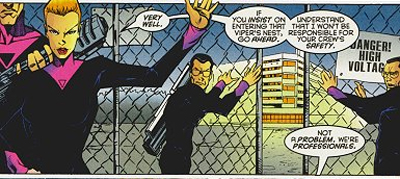

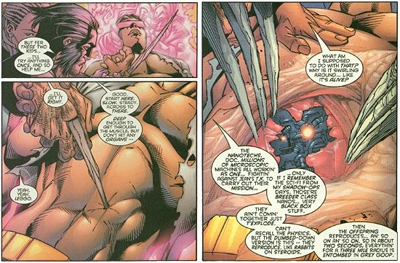
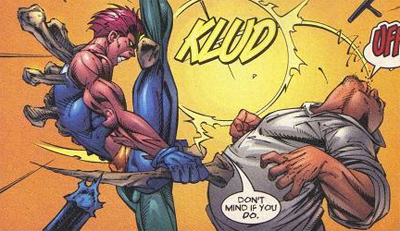

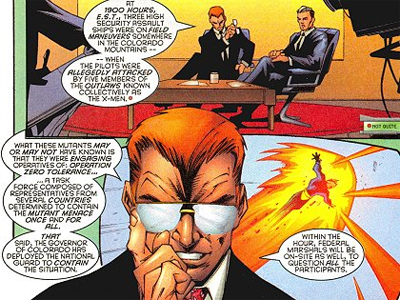


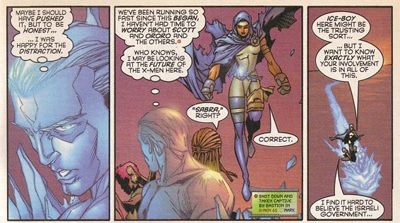
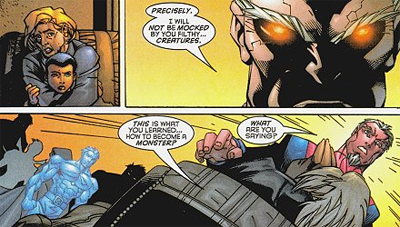







This story line was always a mixed bag for me in temr so fgreat and not so great Xmen stories, did you find my blog on here at Radio of Horror
Can you post a link?
http://www.radioofhorror.wordpress.com
Nice review, Darren. I felt the same way you did about Bastion at first, but I think he became increasingly interesting as the crossover progressed. Cable implies that Bastion actually has reservations about his actions and, in the finale of the main plot, Bastion suggests that in the past he wasn’t exactly human, but seemed to have a deep-rooted desire to become one… a sort of “Pinocchio Syndrome,” if you will. Being human seems to be something he takes great pride in, and he seems to have a deep admiration for humanity in general, as seen in lines like, “The human form I wear was forged from the heat of my compassion for my fellow man!” Bastion’s true nature wasn’t revealed in the storyline– a frustratingly typical trend of 90s X-Men stories and X-Overs (most notoriously “X-Cutioner’s Song, which spent 12 issues hinting at Cable and Stryfe’s true nature yet revealed nothing)– but there are a lot of clues peppered in the story. It’s a pity his identity wasn’t revealed until after OZT wrapped up, as it might have cleared up a few things… the hints alluding to who/what Bastion really were probably were lost on a lot of people who weren’t longtime readers. Let’s just say there was a very clear identity in mind for him…
Anyway, I finished reading the crossover this week and found a lot of it surprisingly enjoyable. The James Robinson/Chris Bachalo issues of Gen X are a bit slow, but a lot of fun, and I really liked the way Robinson wrote Cable and Caliban in the former’s eponymous series. John Francis Moore’s X-Force had a lot of good dialogue and did a nice job fleshing out one of the Prime Sentinels (which didn’t really show much personality before then), and I share your opinion of the Wolverine issues (big fan of Mustang!). Plus, it gave us what at the time may have been a fairly revolutionary take on J. Jonah Jameson. Behind the Spider-Man hate lies a true journalist!
The Jameson scene is a highlight of the crossover.
As for the identity of Bastion, it’s been years since I read the crossover, but I feel like a bit of an idiot. I can’t remember any of the hints.
X-Men #69 had the biggest clues about Bastion’s identity. In it, he says the following:
“There was a time when I was… not unlike you. When I was less than human. As much as I tried to serve and protect the sanctity of humanity — the very essence of that humanity eluded me. But then the day came that I was cast before a judgmental god who deemed me worthy of my most fervent desire. She spoke, and her word transformed me into a man… and sent me to defend my fellow man against mutants.”
I’ve put the most important clues in italics (or tried to, anyway– not sure I did the code right). If you want, however, read on below for the details. Spoilers for a 19-year subplot ahead (ha)…
>
>
>
>
Bastion turned out to be a reincarnated version of Nimrod & Master Mold, who had fused together and had been pushed by Rogue into the Siege Perilous in Uncanny X-Men #247. The “judgmental god” Bastion refers to is probably the Siege Perilous’ original caretaker, Roma, hence “she.” Bastion’s desire to become human probably comes from the part of his psyche influenced by Nimrod, who had posed as a human for a time. Bastion’s desire to destroy mutants probably comes from Mater Mold, as I believe Nimrod had lost his mutant-hunting programming before the two merged. Of course, as I mentioned before, this is really something only longtime fans would have been able to deduce: a prime example of how continuity-heavy/dependent the X-Men titles were in those days.
Oddly enough, Bastion’s true nature was revealed, in all places, in a Cable/Machine Man Annual. I suppose it does make a certain kind of sense, as Bastion and Cable seemed to have a bizarre respect for each other, while Machine Man shares Bastion’s desire to be seen as human. Still, you’d think that an X-Men villain as prominent as Bastion was at the time would have had his identity revealed in one of the major X-Men titles.
Ah!
Thanks for that. It has been forever since I read it. Funny how some continuity sticks with you, and some doesn’t.